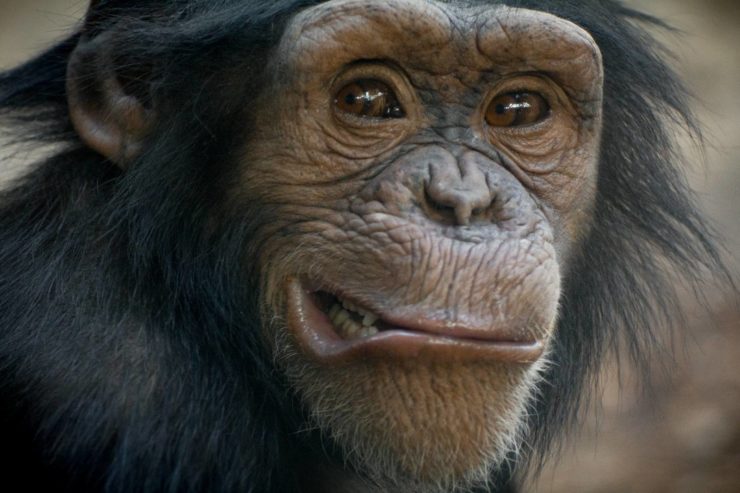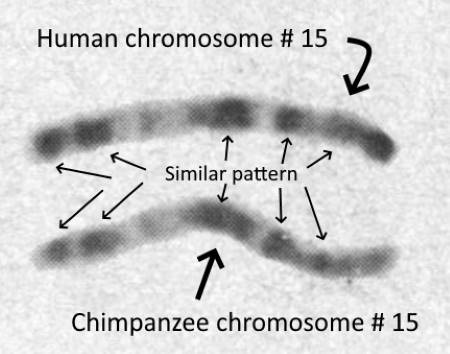You may have heard that we humans have 23 chromosome pairs, whereas our closest neighbors chimpanzees have 24 — one pair more. Do we have to worry that humans have fewer chromosomes than chimps do? What is the function of those extra chromosomes that chimps need and we don’t? Let’s find out.

In reality, while we have fewer chromosomes, it does not mean we have less genetic material. The reason why we have one less chromosome pair compared to chimps is that after our species diverged, two of our ancestors’ chromosomes fused together. This, in essence, means that we neither lost, nor chimps gained a chromosome.
How do we know about chromosome fusion?
When we look at our own genome and that of chimps, we can see some striking similarities. We can observe regions of chromosomes that, though changed a little, still can be viewed as almost identical in both species. It is as if you heard the same story told by different tellers. They may skip, change, or add some parts — they may even change the main characters — yet you would still recognize the same story.
One such method that can identify similar and different parts of chromosomes is called G-banding, which basically is a coloration of chromosomes in a cell sample. It lets us see the chromosomes under a microscope since without staining they don’t quite stand out.
Additionally, these colors create bands, depending on the density of the chromosome in the region. The denser the region, the darker it stains. This lets us place chromosomes of related species side by side and ascertain their similarities. Note that nowadays, we can read the whole genome sequence, and it also shows similar findings.
If we compare the chromosomes of humans and chimps, we can see that they are a close match. Let’s, for example, take a look at chromosome #15 of both species, and see how similar they are stained.

The paper from which the chromosome photo is taken contains images of all the chromosomes, not only from humans and chimps but also from gorillas and orangutans. Take a look and you’ll see that all of our chromosomes have a matching chromosome in the genome of other apes.
All except our chromosome #2. You will see that other apes will have two chromosomes that each match a part of our second-largest chromosome. They are unmistakenly identifiable as the same chromosomes, and apparently we have them both, only fused together.
Since the invention of band coloring in 1982, we have sequenced the whole genome of both humans and chimps, and have been able to identify similar and different parts in much greater detail. Sequences are still recognizable, even though many letters have gotten replaced. For example, if you read two sequences, “CAAGCGCC” and “GAAGCGGC,” you can know they are of the same origin, though some letters are different, in a similar manner to how you can know what the German word “Schimpanse” means even without picking up a dictionary.
Besides that, if we inspect human chromosome #2, we can identify a place where the inactive centromere (a central part of a chromosome) of our ancestral 2B chromosome resides. Centromeres have specific characteristics that don’t appear in other parts of the chromosomes. If these can be seen in places other than centromeres themselves, we can speculate that these are remnants, that, like Stonehenge, no longer serve their initial purpose. Additionally, we also see sequences specific to telomeres (the ends of chromosomes) in the middle of our second chromosome.
Different number of chromosomes, yet a similar number of genes
By some logic, one might think that more chromosomes are better. Hell, we have 23 chromosome pairs, yet fruit flies have only four. Obviously, this should be because they are more primitive, right? Wrong.
In essence, it actually does not matter how many chromosomes you have. Quite a few orchids, for example, have more chromosomes than we do. Chromosome count does not determine how complex the organism is, or how many genes it has. As noted above, the fusion of two chromosomes reduces the number of chromosomes. Yet the number of genes does not change that much.
One chromosome could host from a few to several thousand genes. Saying that more chromosomes are better is like saying that two piles of money are better than one.
Chromosomes are quite a lively bunch and do funny things. They break apart, fuse together, lose parts, copy parts or even invert or move around segments.
Besides the fusion of chromosomes 2A and 2B, the human genome has had some other changes since our divergence from chimpanzees. For example, in chromosomes 4, 5, and others, we can see some inverted segments. And not just when we compare ourselves to chimps. We can see how parts of our genome have been inverted, deleted, or duplicated as we compare our genome with the genomes of other primates.
Interestingly, the further we go back in our evolutionary family tree, the relatively more dissimilarities we observe. The latter observation is nothing new. Biologists have used something called a molecular clock for several decades already. That is, they can take any two or more organisms, look at their genomes, and find how similar their DNA is. The more differences they find, the more ancient their last common ancestor is. That is a striking observation, and you can learn about the molecular clock here.
Thus far, it’s important to note that the reason why humans have one less chromosome than chimps is that a few million years ago, two of our ancestors’ chromosomes fused together. That is why we still have mostly similar genes, even though clear differences in the number of our chromosomes. How changes like these can stick in a species is a topic for another day.